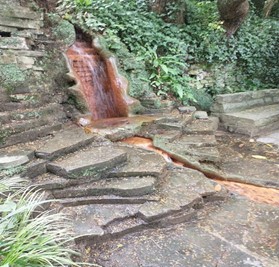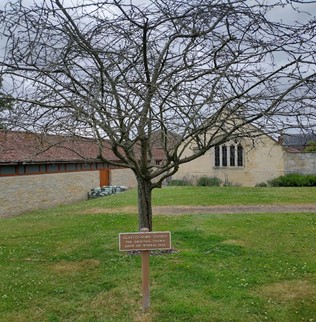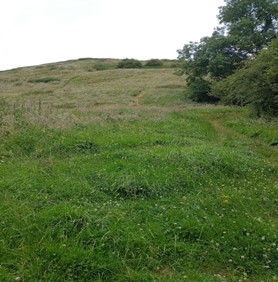The place, not the festival.
In a time when a lot of town centres are almost interchangeable, Glastonbury is unique. You won’t see a Subway, a WHSmith, a Sainsbury’s; you will see Elestial, Sons of Asgard, Hemp in Avalon (and a very discreet Co-op).
Events for a weekday in July don’t include coffee mornings or farm produce sales, but there’s a Gong and Sound Bath, Working with Dragon Magic, Galactic Shamanic Journey, Heart Fire Drum… In September there’s a Portal to Ascension Conference featuring such entities as Magenta Pixie, Lemurian Starchild, Adam Apollo, and Patrick the Wizard. You get the picture. Oh, and there’s a Cannabis Picnic on the day of the full moon in July at Avalon Orchard, on the south side of Glastonbury Tor (for all Weed Lovers and Hempathic Beings).


The people are as eclectic as the shops, more colourful than the tourists. No over-made-up female clones or man buns and skinny trousers here; lots of dreadlocks, hats with feathers, rainbows, and bare feet instead. Enterprising street traders peddle vegan snacks, wooden mushrooms, woolly witches, and jokes (the sign says £1 = 1 joke). A purple-clad wizard stands on a star and crystal strewn banket outside the Abbey offices, offering unidentifiable but no doubt mystic services.
It’s typical of Glastonbury that one of its oldest mediaeval buildings, the Tribunal, has been a merchant’s house, a shop, school, and briefly a convent – but never actually a Tribunal. It is now a museum, and has a wonderful garden full of flourishing medicinal and kitchen herbs, a magnificent walnut tree, and a baby Holy Thorn. The other famous mediaeval building in the High Street is the George and Pilgrims Inn, which has in fact been an inn since it was built in the 15th Century. The food and cider are great, the service charming; there are fairy lights, a suit of armour in the corridor, and a cobblestoned courtyard.


The Red Spring (iron) in the Chalice Well gardens, at the foot of the Tor, and the White Spring (calcium) over the road were once the town’s only water supply; now redundant, they have been coerced to flow into basins and pools watched over by fairies, angels, and goddesses (and a Holy Thorn). Said to have grown from St Joseph of Arimathea’s staff, the original Holy Thorn on Wearyall Hill is no longer there, but several of its descendents still flourish in various Glastonbury places.


Until its destruction in 1539 under Henry VIII, the Abbey was the spiritual centre of the town, and its remains are still physically dominant. The extent of the ruined buildings and the green spaces round them are awesome; but the Abbey’s faith is now just one of many. Glastonbury is proud of its spiritual diversity – by a 2012 count it has around 70 different faith groups – and Christianity here is subdued. No trace of the Abbey’s high altar remains, but the rectangle where it stood is permanently chained off – an interesting sensibility. The tranquillity of the Abbey grounds seems tinged with sadness, and the saddest sight of all is the Holy Thorn by St Patrick’s chapel, which is completely dead.


Evidence suggests that the Tor itself was a holy site long before St Joseph of Arimathea built his church in the 1st Century AD, dedicated to Mary the Mother of God, at its foot. No-one knows when it was first referred to as the Isle of Avalon. It’s difficult now to imagine the surrounding area as a sea, but in those days the Tor would have risen out of the water like a beacon. There must have been a Christian/Pagan standoff even then; the chapel on the Tor’s dedication to St Michael means that he was enlisted to keep the pagan entities under control.
Like its myths and legends, the Tor is elusive; you can’t see it from the town (except a glimpse from St Dunstan’s car park), and you often can’t see the tower from the Tor itself until you’re nearly on top of it. It’s a strange place, where the famous ‘vibes’ aren’t quite smothered by heavy traffic on the circling roads. Up a tiny lane is a mural depicting the legend of King Arthur and his knights sleeping under the Tor. It’s probably unintentional that the knackered knights seem to be using their horses as airbeds (see below).
Glastonbury can be an intense experience. Is it a quaint town by a bump of a hill with too many weird shops but no pharmacy? Or a gateway to ancient mystical and spiritual forces? That depends on what you bring to it (and your sense of humour). It lays claim to a plethora of saints: Our Lady of Glastonbury, St Joseph of Arimathea, St Michael, St Dunstan, St Patrick, St Bridget… and a number of gods and goddesses and extraterrestrial beings. Take your pick.

